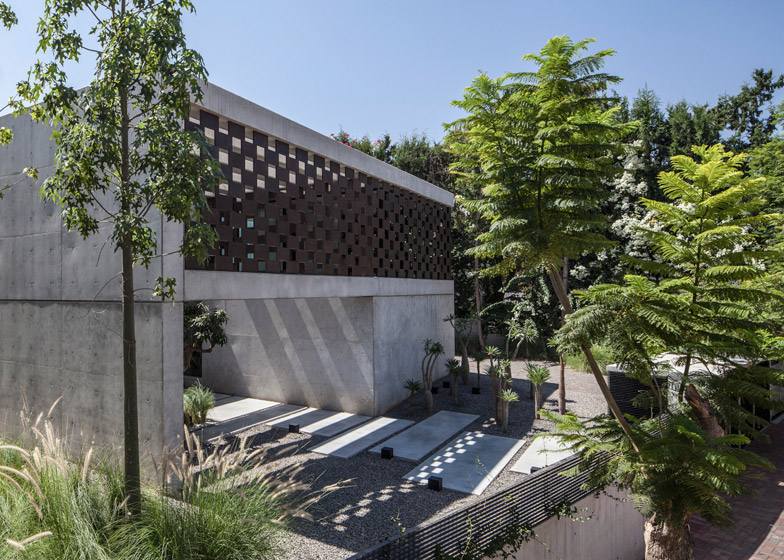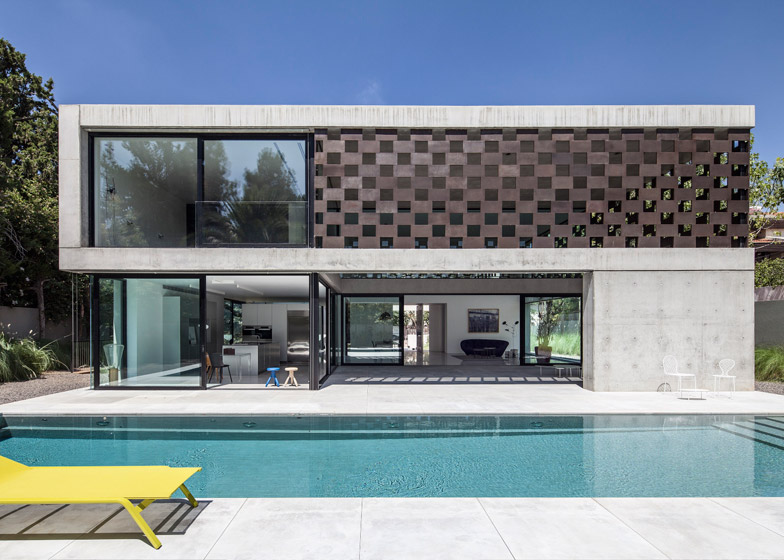Weathered steel screens cast chequerboard patterns of sunlight and shadow across the internal surfaces of this house near Tel Aviv by Israeli architect Pitsou Kedem (+ slideshow).
The property was designed by Pitsou Kedem Architects for a plot located in the district of Savyon, 20 kilometres east of central Tel Aviv.
The main volume of the building is a concrete shell that extends around a courtyard, but also frames the large glazed surfaces or openings containing the gridded metal screens.
These see-through surfaces perform several purposes – controlling the amount of daylight that enters the building, limiting views from outside and helping to demarcate boundaries between various internal and external spaces.
"The weathered steel layer is seen as being two dimensional from afar but does, in effect, have volume and can be experienced almost as a piece of sculpture or work of art, and not just in terms of its function as part of the building's structure," stated the studio.
A courtyard marks the entrance to the house and is sheltered on two sides by tall concrete walls. At first floor level, the concrete frames the metal screen, which extends along the front of the building and wraps around the corner to shield a bedroom.
Another courtyard at the other end of the house creates a transitional area between the living area and the pool. This also becomes carpeted in a pattern of dappled sunlight as it filters through the screens that flank it on two sides.
The project's title, In Praise of Shadows, references the importance the designers placed on the relationship between the house and the sun. The sun's orientation helped to determine several key factors, including the position of walls and the internal programme.
The choice of simple raw materials, including exposed concrete, was intended to enhance the "inanimate" and "monastic" properties of these surfaces.
"The shade and shadows moving across the building's surfaces create a dynamic drama that makes the entire mass seem to be alive and full of movement," the studio added.
The changing angle and brightness of the sun affects the tone of the concrete, weathered steel and wood used throughout external and internal spaces.
A partition comprising staggered open shelves and solid storage units separates the dining area from a glass-walled study on the ground floor, evoking the metal panels employed around the exterior.
A similar shelving system lines one side of a mezzanine above the main living area and allows light to filter through both from this side and the side facing the front terrace.
Glass walls enhance the open-air feel of the ground floor, where residents can look out onto the pool from the living room and kitchen.
Glazing also surrounds small courtyard gardens. One is positioned next to the main stairwell, containing a tree that reaches up from the basement level.
In first floor spaces such as the master bedroom, the pattern of light and shadow cast by the perforated metal screen outside the glass wall evokes the effect of dappled light filtering through the nearby trees.
Photography is by Amit Geron.
Project credits:
Design team: Pitsou Kedem, Irene Goldberg, Hila Sella
Styling for photography: Eti Buskila and Irene Goldberg




























